Roden 1/48 Sopwith 1 1/2 Strutter "Comic Fighter" By Greg Balzer | 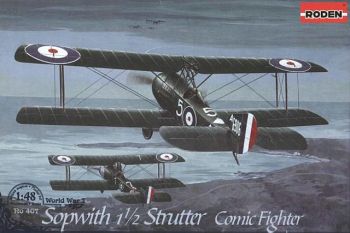 | History Designed by the Sopwith Aviation Company in Kingston on Thames by Thomas Sopwith, the Sopwith 1 1/2 Strutter was first known as the Sopwith LCT (or Land Clerget Tractor). The aircraft made its maiden flight in December 1916 and following successful trials was put into limited production as requested by the Admiralty. 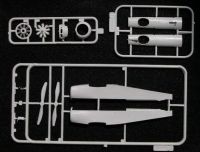 The Sopwith 1 1/2 Strutter owes its name to the unusual cabane struts, which form a distinctive "W" shape, and which gave rise to its rather suggestive title. The aircraft would boast several other unique features for its day, being the first Allied fighter equipped with a synchronized Vickers gun that fired through the propeller, and being the first to sport air-brakes and an adjustable tailplane. The Sopwith 1 1/2 Strutter owes its name to the unusual cabane struts, which form a distinctive "W" shape, and which gave rise to its rather suggestive title. The aircraft would boast several other unique features for its day, being the first Allied fighter equipped with a synchronized Vickers gun that fired through the propeller, and being the first to sport air-brakes and an adjustable tailplane.
Following initially delivery, additional orders were placed for a two-seat version, designated Type 9400, intended as a fighter, and the single-seat (Type 9700) as a bomber. In late 1917 the Germans revised their air campaign against the British Isles, employing night bombing raids in order to reduce losses to their strategic bombers. The newly created British Home Defence relied on a hodge-podge of retired fighters, including a few two-seater Sopwith 1 1/2 Strutter fighters. Captain F.W. Honnett, Flight Commander of "A" Flight No. 78 Sqn (HD) RFC, suggested modifying of one of the two-seat Strutters by moving the pilot's seat and all the controls into the observer's position to improve visibility. As a result, the original pilot's position was faired over, and the plane was equipped with a night searchlight. 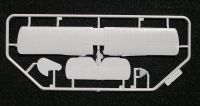 The pilots who flew this modified aircraft dubbed it the "Comic Fighter". Initially armament consisted of a single, forward firing Vickers gun. Later Comics were equipped with a Lewis gun on a flexible Foster mounting, and one aircraft, namely B'762, had two Lewis on a special fixed mounting that fired at a 70º angle. The pilots who flew this modified aircraft dubbed it the "Comic Fighter". Initially armament consisted of a single, forward firing Vickers gun. Later Comics were equipped with a Lewis gun on a flexible Foster mounting, and one aircraft, namely B'762, had two Lewis on a special fixed mounting that fired at a 70º angle.
1 ½ Strutter Comics were intensively used by 78 Sqn until February 1918, flying night intercept missions against Gothas and Giant R-planes. Due to the poor performance of this type, it was never put into series production and in early 1918 the 1 1/2 Strutter was replaced by the night fighter version of the Sopwith Camel (which ironically was officially named the Sopwith Comic). The Kit This is the third in a series of 1/48 Sopwith 1 ½ Strutters released by Roden. The two previous versions of the Strutter being a single seat bomber (kit # 404) and a two seat fighter (kit #402). Unlike its predecessors, which were molded in clear plastic, the Comic Fighter (kit #407) is molded in a more traditional light gray. 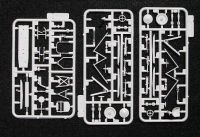 On close inspection it appears as though the kit relies upon its predecessor's molds as the kit contains parts for all of the 1 ½ Stutter versions Roden has released, with an additional sprue containing the cockpit covers for two different single-seat Comic versions. Decals and armament are included to model either the Hooper built A'6906 flown by Lt. J.S. Castle or B' 762 which appears to have been a general use fighter, it having not been assigned to any one pilot in particular. On close inspection it appears as though the kit relies upon its predecessor's molds as the kit contains parts for all of the 1 ½ Stutter versions Roden has released, with an additional sprue containing the cockpit covers for two different single-seat Comic versions. Decals and armament are included to model either the Hooper built A'6906 flown by Lt. J.S. Castle or B' 762 which appears to have been a general use fighter, it having not been assigned to any one pilot in particular.
The kit is well detailed with the fabric effect on the fuselage being rather pronounced. This may confound some purists, but the effect appears consistent with photos of surviving aircraft. There appear to be no mold sinks or ejector pin marks, and overall the parts are very well molded with only a small amount of flash on a few parts. The gates on some of the smaller parts may be a little oversized, so care and patience is recommend when removing the small bits from the sprue. 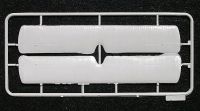 A photoetch set is included for detailing pushrods, rigging, the instrument panel, and a few other sundry details, and it appears as though not all of the photoetch is intended for use on this particular kit. A photoetch set is included for detailing pushrods, rigging, the instrument panel, and a few other sundry details, and it appears as though not all of the photoetch is intended for use on this particular kit.
As previously mentioned, the kit comes with two sets of decals, those for B'762 and A'6906 flown by Lt. J.S. Castle, both of 78 Sqn Home Defence (HD). The decals are in register, appear to be very thin, and the colors appear to be appropriate for the aircraft depicted. The instructions provide clear, concise construction drawings, to include rigging plans. The inside cover spread contains a full sprue diagram showing the layout of all the parts and the identifying numbers. The inside sheets contain detailed, and comprehensive diagrams of the twelve assembly steps. The last page contains two-view diagrams illustrating painting/decal placement for both aircraft represented. Conclusion 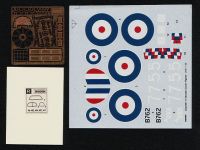 The fact that this aircraft was not produced in large numbers and was not one of the more glamorous frontline fighters means that it has been overlooked by the large scale modeling manufacturers. Roden should be applauded for providing the modeling community with a faithful representation of this unique aircraft, and anyone interested in WWI aircraft should seriously consider this kit, as well as the others in the series. The fact that this aircraft was not produced in large numbers and was not one of the more glamorous frontline fighters means that it has been overlooked by the large scale modeling manufacturers. Roden should be applauded for providing the modeling community with a faithful representation of this unique aircraft, and anyone interested in WWI aircraft should seriously consider this kit, as well as the others in the series.
Our thanks to Roden and Squadron for the review kit. References Albatros Productions LTD, Windsock Datafile #34, Sopwith 1 1/2 Strutter
Albatros Productions LTD, Windsock Datafile #80, Sopwith 1 1/2 Strutter, Volume 2
| 







|
